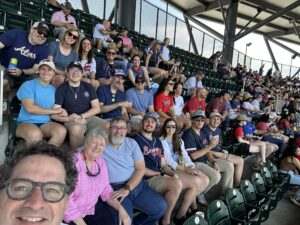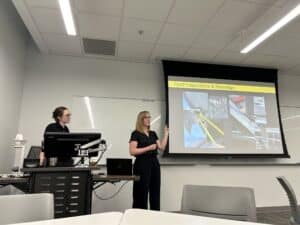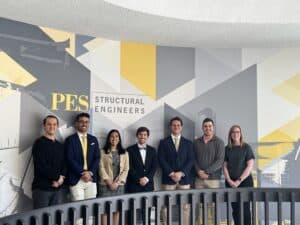
Why Structural Engineering Recruitment Is Continuously Evolving
Structural engineering is a specialized and relatively small profession. With an average employee age of 43 across the entire engineering industry, a modest number of students pursuing structural programs, and a demanding path toward professional engineer (PE) licensure, it’s a profession that values depth of knowledge and long-term commitment. The result is an industry where firms and engineers alike prioritize quality, mentorship, and career growth. At PES, we see the industry’s size as a strategic advantage – it enables us to build strong relationships, develop talent intentionally, and maintain the high standards our work demands.
How We Design Retention Into Everyday Work (Pods, Mentorship, Variety)
To design retention into everyday work, we moved away from the traditional “principal-owned studio” model to cross-functional project pods that ensure meaningful project variety and professional development. Each pod is led by project managers with different specialties, and through our annual experience-balance review, we intentionally take note of the experiences gained by team members over the year and staff projects accordingly so people see multiple materials and markets early, learn faster, and avoid getting pigeonholed. Most importantly, this structure gives young engineers room to shape their own career trajectory through hands-on experience while letting us staff the best-fit team for every project, because each job is unique and benefits from a tailored mix of skills.
Complementing the pods, our engineering mentorship program pairs new hires with a mentor for their first year, with encouraged quarterly check-ins and the option to continue or select a new mentor afterward. Together with the annual review, where we map who you worked with, the project types you touched, and any gaps, these practices keep engineering career development intentional, not accidental.
Our growing internal quality assurance program not only strives for technical excellence but also serves as a powerful retention tool. Through multiple layers of review, engineers gain confidence knowing their work is supported by a system of accountability. The internal peer review process exposes team members to diverse perspectives and problem-solving approaches, fostering continuous learning and professional growth on every project. These shared insights and lessons learned are carried forward to future projects and teams, strengthening individual expertise and contributing to a quality product for our clients.
Supporting the EIT-to-PE Journey
The PE exam pathway (and SE track) remains a challenging point during an engineer’s career. At PES, we’re committed to helping our engineers achieve licensure and do everything we can to support them on that journey. Our response is practical:
- Cover exam costs/resources where possible and facilitate peer study opportunities.
- Provide tailored continuing education focused on exam content and professional growth.
- Stay in tune to engineers’ specific needs and continually look for new ways to strengthen our support.
These are a few examples of straightforward steps that could help engineers cross the finish line without burning out.
Culture, Flexible Benefits, and Sabbaticals That Keep Great People
Small rituals matter: Thursday afternoon break-room hangs, inclusive team events, Braves game outings, office Olympics, community service, and more. All of these create belonging within a deadline-driven profession.

Outside of work, we encourage involvement in professional societies, conferences, and committees across the industry and local community. This builds networks, leadership skills, and technical depth, which is tremendously beneficial for our employees, us, and our clients.
What candidates tell us they notice about PES:
- Transparent leadership, shared ownership. We staff the best-fit team for the project, not just the team tied to a relationship owner.
- A people-centered engineering culture that fosters collaboration and empowers entrepreneurial growth.
Why Retention Improves Project Delivery

In practice, you see the impact in day-to-day execution. Engineers who’ve grown through our mentorship program and experience-balance reviews spot coordination challenges earlier because they’ve touched multiple materials and market types. And because pods share lessons learned across projects, refinements to our details and processes cycle back into the next job to improve constructability and coordination instead of walking out the door.
Client-side outcome examples:
- Fewer RFIs and change orders
- Faster submittal and shop-drawing turnaround
- Smoother coordination
- Greater trust and predictability
- And more!
Looking Ahead: Compete Differently, Grow Intentionally
We expect structural engineering recruitment to favor firms that:
- Lead with transparency and a people-centered focus
- Offer visible engineering career development paths (breadth early; depth by choice).
- Support the EIT to PE journey with time, resources, and community.
- Use milestone benefits, like a sabbatical, to signal long-term commitment and fight burnout.
- Keep experienced engineers through autonomy, recognition, and meaningful work
If you value a place where you can grow, contribute, and be supported for the long game, we’d love to talk!
FAQs
How do your project pods help early-career engineers?
Pods make project variety intentional so you develop faster than you would in a narrow studio. We also run an annual experience-balance review to close exposure gaps.
What does your engineering mentorship program include?
A dedicated mentor in year one with quarterly check-ins, then the option to continue or choose a new mentor you’ve connected with. It keeps career conversations active.
How do you support the EIT-to-PE transition?
We provide exam resources, encourage peer study sessions, provide targeted continuing education content, all aimed at burnout prevention and successful licensure.
What’s the sabbatical policy?
Every 10 years, team members receive a four-week sabbatical with a stipend, in addition to PTO. Coverage is planned so you can truly unplug. It’s designed to reward longevity and prevent burnout.
What makes your structural engineering recruitment approach different?
We strive to build long-term relationships in a close-knit profession.

